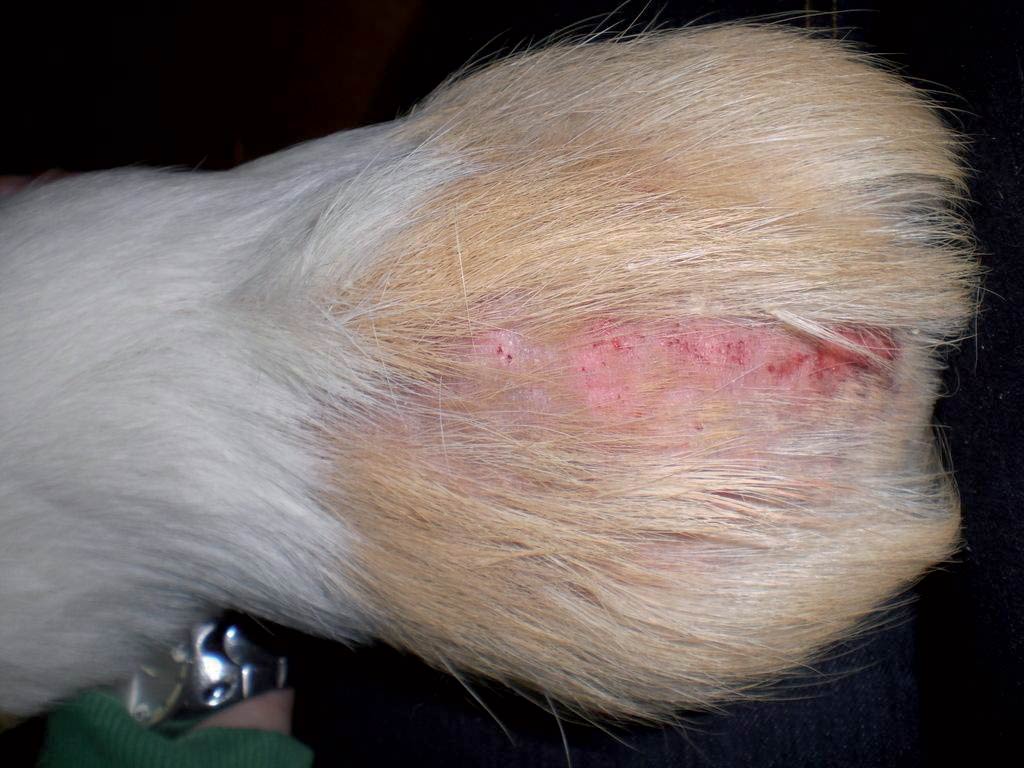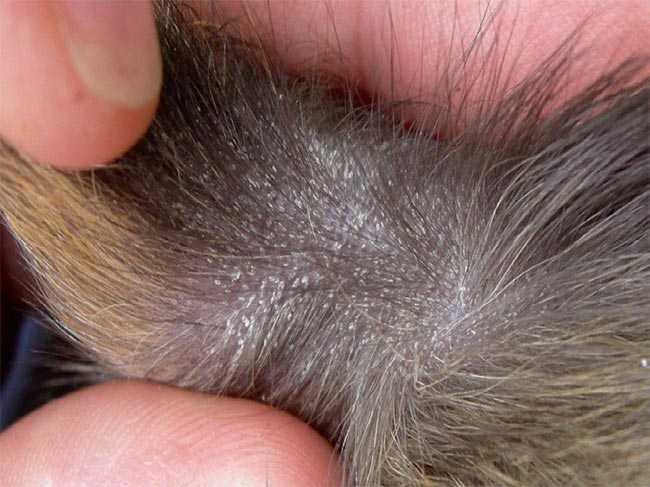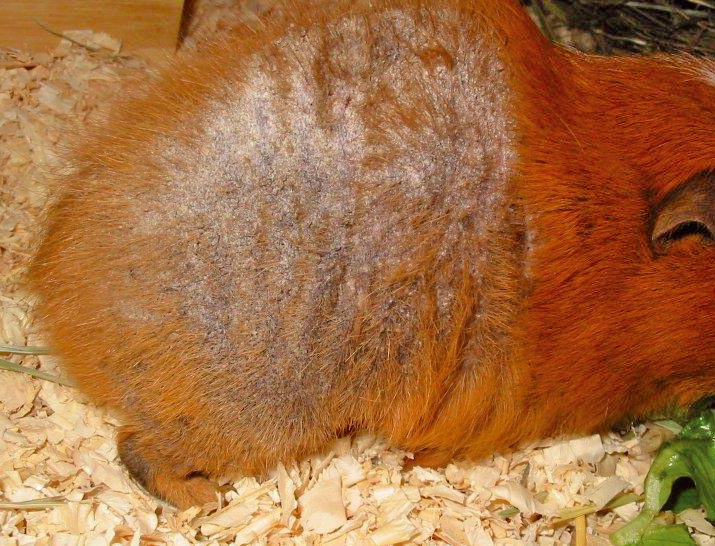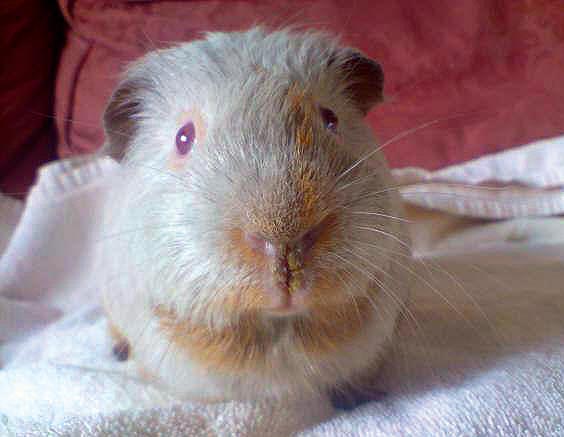22 Jun 2009

Figure 6. Crusting lesion on the nose. In this case, the lesion was fungal in origin and responded well to topical treatments.
Skin problems are one of the most common reasons why guinea pigs require veterinary treatment; they have very sensitive skin and are prone to fungal and parasitic problems.
Guinea pigs originate from Peru, where the climate is warm and dry. Fungal skin infection is a particular problem in the UK as there is always moisture in the air: cold and damp in the winter and hot and humid in the summer. Often, guinea pigs present with both fungal and parasitic problems at the same time and need treating for both.
These mites, commonly known as mange, burrow under the guinea pig’s skin, causing intense pruritus and excruciating pain. Look carefully and you will see small bumps just under the skin in the area of infestation, often with some blood on the top. These are the mites that have burrowed into the skin, causing the animal to scratch, and are usually found in the middle of the back in a V shape. The hair around the infested area is often thinning and may be broken off halfway down the shaft. Guinea pigs bite and scratch themselves to gain relief from the irritation, regularly causing open sores that can become infected.
The problem is usually solved when patients are treated with two to three doses of ivermectin, 14 days apart. Ivermectin is very effective and usually works within a few hours to relieve the pruritus. Topical spot-on preparations are available for use in guinea pigs and other small animals. If there is a lot of scurfy skin or debris, then the patient can be shampooed, but always leave 48 hours between ivermectin treatment and shampooing. All guinea pigs in contact with the patient should also be treated.
Guinea pigs often carry mites and show no symptoms. However, the mites can breed and cause skin problems when the animals are subjected to stress, such as when moving home, following pregnancy and illness, or through old age (Figure 1).

These mites, commonly known as hay mites or static lice, are tiny mites that feed off skin debris and adhere to the outer half of the hair shaft, commonly around the rump. They often come in with hay – hence they are sometimes known as hay mites. Eggs are also laid on the hair shaft and look like small dust particles on a light-coloured pig. These are the least damaging of the parasites, but still need to be removed from the hair.
Commonly known as running lice, these parasites act like static lice, feeding off skin debris. They can usually be seen moving at the bottom of the hair on the skin surface as they try to avoid the light. Running lice are more easily visible on areas with dark hair. They are about 1mm long and look like tiny wriggling worms. Their eggs are laid at the base of the hair, near the skin, and look like small specks of dust.
This is a host-specific type of lice: easily spread between guinea pigs, they are often picked up at shows, from grass in the summer or from others in the same cage. All guinea pigs in a family will need to be checked and treated if any have lice.
Both types of lice can be easily treated with a shampoo designed specifically for guinea pig lice. Two rounds of shampoos are required each time (with the second one left on for five minutes), one week apart, to ensure that the lice, nits, eggs and lice subsequently hatched from any eggs left behind after the first round of shampoos are removed from the hair (Figure 2).

Fungal infections often start on the face, especially around the eye and ear areas, and can cause itching and subsequent open sores. Normally, a white powdery “bloom” will be seen on the affected area. Other areas commonly affected are the back and hindlimb areas. Typical symptoms include hair loss around the affected area (hair comes out easily with dead skin attached to the end) and crusty, scabby skin with hair stuck together with serum from the skin below.
Ringworm can spread rapidly between guinea pigs living in the same area, and also from guinea pigs to humans and other animals. Therefore, care needs to be taken with hand and clothing hygiene. This type of skin problem can be treated with antifungal dips, topical creams and/or orally with off-label use of feline antifungal medications.
Aromatherapy products are also useful for fungal skin conditions, but they must be correctly formulated for guinea pigs – using lower doses of essential oils than would be used for humans. Shampoos that contain manuka and neem (to remove scurfy skin), lotions that contain lavender and myrrh for general fungal skin problems, or manuka specifically for ringworm have proved to be particularly effective (Figures 3 to 5).

This is often seen in older sows on their flanks and may be associated with ovarian cysts. Hair can sometimes become thin or there may be complete hair loss from the area around the ovaries. Sows can have ovarian cysts without showing any symptoms, while others develop large cysts, which can cause discomfort in the abdominal area. Cysts can be visualised using ultrasound. Treatments include off-label use of hormonal preparations or surgery to spay the guinea pig.
Sows may experience thinning of the hair or hair loss associated with pregnancy and lactation, as hormones can affect the function and growth of hair. This can happen in the later stages of pregnancy and shortly after parturition and can cause symmetric alopecia on the flanks. As long as there is no other underlying problem with the patient, such as lice or mites, the hair will usually grow back without requiring any treatment.
Guinea pigs can present with crusty sores around the mouth and lip area and up towards the nose. This type of problem is often fungal in origin, so treatment with antibiotics – either orally and/or in the form of a cream or gel – may not work. If this is the case, it is worth considering off-label use of human antifungal topical preparations. Sometimes, sores can be caused by the guinea pig eating acidic fruit, such as an apple or tomato, so it is always worth removing these from the diet to eliminate the possible cause (Figure 6).

Hair can be chewed off, either by the guinea pig itself, or by a cage mate, and may be caused by boredom, stress, a behavioural problem or lack of hay. When cage mates chew the other animal’s hair, it can be from any part of the body. When a guinea pig is self-barbering, hair will only be missing from places that it can reach, so the culprit should be easy to identify. Ensure that the guinea pigs concerned are given unlimited access to plenty of fresh, green meadow hay to keep them occupied – this will often stop the problem.
Guinea pigs have naturally bald patches on two areas of the body that owners may not be aware of and, as a result, become worried about:
Regular monthly shampooing of the guinea pig keeps the skin clean and may help to prevent problems from happening in the first place.
Damp bedding can freeze when guinea pigs are caged outside during the winter without any protection from the cold, damp or wind (not recommended). As a minimum, these animals should be kept in a shed or outbuilding and protected from the elements. Keeping them indoors or in a heated shed is even better.
Don’t use shavings or sawdust for bedding. Although these products are excellent for absorbing urine, they can also remove natural oils from the guinea pig’s skin and leave it prone to skin problems. Instead, use soft, fresh green hay or short-chopped straw on top of a thick layer of newspaper and clean and disinfect the cage at least twice-a-week.
Barley straw, which is used for rabbits, is not suitable for guinea pigs, as it may cause eye poke injuries due to its length and coarseness.
Regular inspection of the guinea pig’s hair, skin, ears, nose, mouth, feet and body, together with an awareness of what is normal scratching, will help identify skin problems sooner rather than later. Look for any signs of redness, dry flaky skin, hair coming out in clumps with dead skin on the end, cuts, bites and open sores. Take immediate action if anything suspicious is found, as skin problems can kill guinea pigs if left untreated.